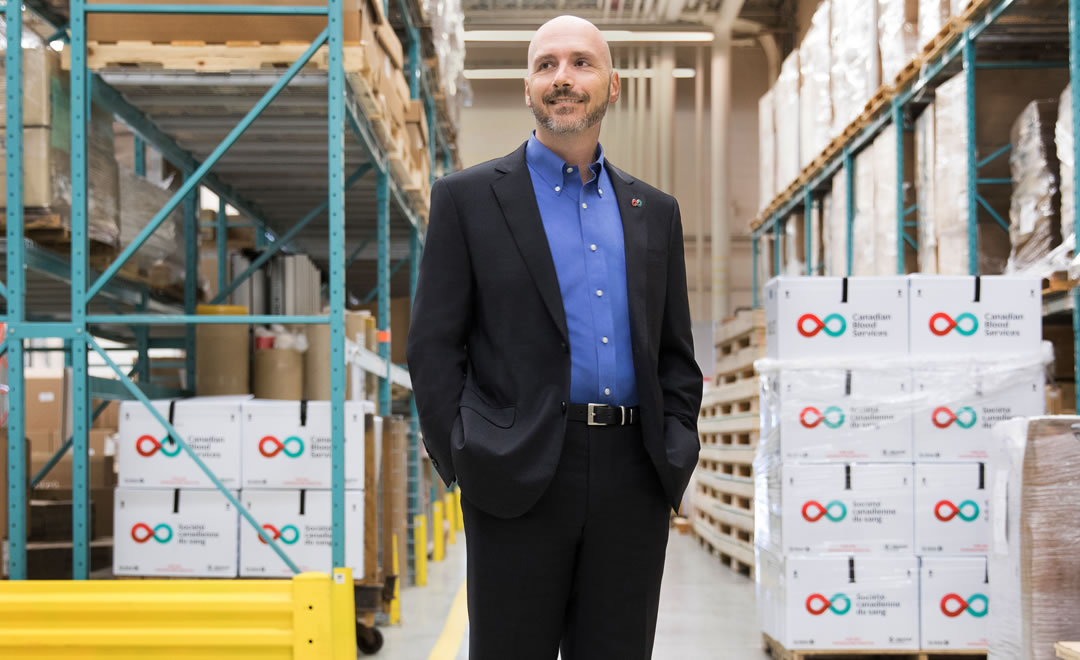
Dr. Sylvain Grenier: director, plasma protein products formulary, Canadian Blood Services
We have to make sure the right products are available while also making limited dollars go further to keep the system sustainable.”
For clinical pharmacist Dr. Sylvain Grenier, director of our plasma protein products (PPPs) formulary, managing this national program is an intricate balancing act with one guiding purpose; to ensure access to the consistent, effective, appropriate care that patients need.
You’ve taken on this new role at a time when the use of PPPs continues to grow dramatically. How is the Canadian Blood Services formulary evolving to keep pace?
In the past, when there were relatively few products available, the formulary focused mainly on managing supply. As new drugs were approved by the provincial and territorial (P/T) health ministries, we would list them, ensure they got to the patients who needed them and, of course, negotiate the best possible contracts.
In recent years, though, we’ve seen a significant increase in the number and complexity of products used to treat conditions resulting from plasma protein deficiencie, so there’s a need for more clinical oversight of the formulary. Often a condition can be treated with multiple products, each with its pros and cons. For example, a product may be more beneficial for treating an illness in a subset of patients but not as effective for others. The challenge is determining which products best meet patients’ needs. And because the formulary is publicly funded, we also have to make sure that any product we recommend listing in our formulary is considered from the perspectives of cost and sustainability.
How has this evolution affected day-to-day management of the formulary?
Like the provincial drug plans, we’re developing a more robust product selection process that will include more patient consultation. For one thing, we’re gathering more information on how products are actually used after they leave hospital blood banks; this kind of clinical insight will be vital to our decision-making. We’re also introducing the concept — again, like many drug plans — of limited use, in which access to some products is restricted to those patients who will benefit the most.
Can you outline the product selection process?
The current process has two main stages. The first is a medical-scientific review, which looks at all aspects of efficacy and safety. If a product doesn’t meet our standards in those areas, obviously it’s not going to be listed.
A product that passes the initial evaluation moves on to a pharmacoeconomic review. This second stage is in collaboration with the Canadian Agency for Drugs and Technologies in Health (CADTH). We determine, first of all, whether any other products are currently being used to treat the same condition. If so, does the new product represent a more cost-effective alternative? It’s not as simple as just saying the cheapest one wins. If a higher-priced product, for instance, requires less resources when it’s administered, it may be more economical for hospitals to use — and more desirable from a patient perspective — so that has to be factored into the assessment.
If it’s a brand-new product for a condition that previously had no treatment available, the pharmacoeconomic review examines the impact on patients in terms of quality of life and whether it may help them live longer. Once again, the decision to list involves balancing efficacy against cost, as with any drug in the Canadian marketplace.
As part of our continuous improvement effort, we’re increasing our collaborative work with CADTH to share more of our respective expertise. We are seeking to develop a new process that also includes a critical consultative step with patients, which is similar to the process now used to evaluate drugs coming into the Canadian market for coverage by drug plans.
Once the review process is complete, how is the listing decision made?
We forward the results to the P/T health ministries, along with our assessment of patient and clinician preferences, as well as the potential impact on existing drug contracts and inventories. Officials from the various governments then confer and arrive at a decision. If a product is listed, we move quickly to get it in stock and set up distribution.
How do you arrive at pricing agreements with drug providers?
Canadian Blood Services issues requests for proposal (RFP) every few years which invite competitive bids from providers. If new categories of drugs or new therapies become available between the RFP cycles, vendors submit financial information to CADTH as part of the pharmacoeconomic review. If certain products aren’t found to be cost-effective, there are opportunities for Canadian Blood Services to negotiate with providers for better pricing.
The RFP process applies to entire categories of drugs in which there are multiple products available. Efficacy and safety have been established; now we’re focused on balancing patient and clinician preferences against getting the best possible price. Still, the evaluation must take other key considerations into account. For example, we look at how a product would impact patients and clinicians and how easy it is to transition between drugs. When these kinds of factors are part of the calculation, a product with a higher cost may nevertheless deliver better overall value.
So, there are a lot of moving parts to every decision and they change over time.
What determines the quantity of specific products in the formulary?
We make forecasts based on the best current data, but because there are so many variables, it can be difficult. For example, during the past year, we had a shortage of some subcutaneous Ig (SCIg) drugs, which patients can inject themselves (see related story). The intravenous versions of these products were available, so no patient was without Ig. But supplies were shrinking fast as demand rose much higher than predicted.
One factor affecting this situation was an increase in the number of patients receiving Ig drugs for neurological disorders. This is a promising new area of treatment, but doses are about three times higher than for patients with immune deficiency. Another issue was that many hospitals prioritize medical day-care spots for patients requiring procedures that can only be performed on site. With subcutaneous Ig, patients can administer their own treatments at home. That option isn’t necessarily cheaper, but by freeing up these spots, hospitals are able treat other patients and reduce wait-times.
The reason we were able to ensure that no patients went without Ig products is because we manage a national formulary, collaborating with provincial and territorial governments, as well as patient and clinician groups. From my perspective as a practicing pharmacist, drug shortages occur on a regular basis. There are close to 2,000 shortages in Canada as we speak, and in some cases patients have to go without. It was gratifying to see that during the SCIg shortage, patient care was not interrupted, thanks to coordinated management with our providers and other key players.
How do you ensure overall security of supply?
Some of the disorders treated with PPPs affect a relatively small number of patients, so we don’t have to keep a large supply on hand. And in the event of a disruption, there are typically several other multinational providers we can turn to for additional supplies. For products that we need in larger quantities, we’ll consider having contracts with more than one provider, but we have to weigh that against the advantage of being able to negotiate a lower unit cost from a single vendor. Also, if we do stock two similar drugs, there’s still the challenge of predicting whether one may turn out to be preferred by more patients or their doctors.
So all these factors make it hard to predict the future. It isn’t just a matter of doing a cost comparison between two options. Increasingly, the P/T health systems are considering the medical, scientific, economic and social aspects in a more holistic analysis.
What role do patients play in managing the formulary?
Clearly patients understand better than anyone what it’s like to live with their conditions, so what they feel is important must be seriously considered in our decision-making. We’re incorporating more patient consultations into the product selection process. And in our RFP evaluations, representatives of patient groups have a place at the table alongside physicians, health-care leaders and our own medical, financial and supply chain experts.
Moving forward, we expect the formulary will have even more input from patients and other stakeholders. As demand for PPPs continues to grow, we have to ensure that the right products are available while also making limited dollars go further and keeping the system sustainable. It’s a big challenge and one that we’ll only meet if we’re all working together.
